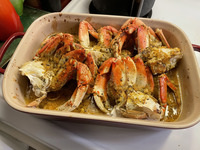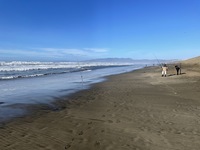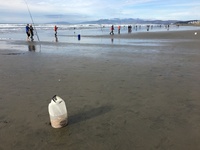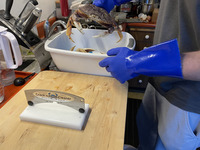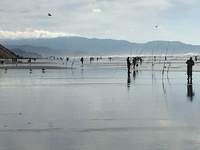 |
| Angelika/Mike Schilli |
|
|
|
Michael I still remember clearly when I had dungeness crab for the first time, many years ago. We were up in the wine country, in Napa Valley, at a now defunct establishment called "Tra Vigne", and we had just managed to snag a spot at the bar. I ordered the daily special, a giant crab, along with a type of beer I had never heard of before, "India Pale Ale". I initially thought it came from India. Okay, folks, that was twenty years ago, nowadays everyone knows better! I clumsily fumbled with the cracker, picking the meat out of the crab's leg shells until my fingers were all greasy. It tasted great, and also since then IPA has been my favorite beer.
And that was, as I said, over twenty years ago; nowadays a Dungeness crab in a restaurant can easily cost fifty to sixty dollars, and even if it is served whole, you can only eat the meat from the total of two sets of five legs and claws. Under the center shell there is only inedible sludge and gills, and this is usually removed in the restaurant kitchen before the actual cooking so as not to affect the taste of the muscle meat. So if the guest thinks to himself after eating the legs "oho, now I'm going to the main course and take off the breastplate of the arrangement," he will be taught otherwise, because underneath, thanks to the chef's work, there is only emptiness.
The preparation is incredibly simple, you just cook them in salted water until they are completely red and brush some butter on them or serve them with butter sauce for dipping. Vietnamese restaurants like Thanh Long in San Francisco steam Dungeness Crab elaborately in their garlic kitchen, which is also super delicious, but you should not talk to anyone at the office on the next day without keep at least six feet of distance. Because of the magical price limit of 50 dollars, above which hardly any dish can be sold in a restaurant, many restaurants have moved on to serving cheap frozen and often already cooked Dungeness Crab from God knows where, but they don't taste as fresh.
Incidentally, whenever I call these crabs "Krabbe", Angelika corrects me because in Northern German "Krabbe" actually means "shrimp" or "prawn", which by an activity called "Puhlen" (a technical term from the region) can be stripped from their shells by hand. These are also very tasty, but they are a completely different culinary category. On Wikipedia, however, it says that the word "Krabbe" can also be used to refer to such ten-legged creatures as the Dungeness Crab, although this species only occurs in the North Pacific off our doorstep and not in the Atlantic Ocean, North Sea or the Mediterranean Sea.
Crabs, like all crustaceans, are very difficult to kill in humane ways. The simplest way to prepare them is therefore to throw the still living but chilled crab in boiling salt water. The sludge and gills under the breastplate, however, then start clouding the water and thus changed the taste of the otherwise pure meat. Some gourmets swear by this "buttery" taste, which mainly comes from the liver of the crustacean, which has also absorbed all kinds of toxic substances from the ocean. We did a crab cooking class a few years ago and learned there that you should gut the crab before cooking to get a cleaner taste.
With the crab splitting machine from the manufacturer "Crab Teal", which consists of only an upright, slightly sharp-edged sheet metal, crab preparation can be moved to a professional level. The amateur cook puts the still living crab with the breastplate on top of the upright blade and then hits the back plate of the crab with the flat hand with force from above, so that the blade penetrates from below through the entrails of the crab and gives it the coup de grace. Then the five legs on each side are torn off along with the side armor and attached armor meat, the whole thing is shaken briefly so that any entrails and gill worms that may still be attached are falling off, and only the edible crab meat is cooked in its shell in salt water. Incidentally, it is important to salt the cooking water properly, since the crab has lived in the sea with a high salt content. Cooking in unsalted water would deprive the crab of its own sodium content and would result in a loss of flavor.
Asian markets in and around San Francisco sell Dungeness Crab fresh and alive during the season for about $10 per pound. Customers point to an aquarium with hundreds of wriggling crabs, the seller fishes out the desired ones, and packs them into a bag, where they continue to wriggle. This way they can be quickly taken home, taken out of the bag, and placed in a bucket with ice and a wet towel on top into the refrigerator. After 15 to 30 minutes the crabs are then stunned and either thrown directly into a pot of boiling water, or killed beforehand with a screwdriver or the Crab-Teal tool described above. Incidentally, live crabs are only to be grabbed from behind, with the thumb on top of the shell and the four remaining fingers of your hand on the underside. Anyone who makes the mistake of coming within reach of the powerful front claws will soon regret it. On Youtube you can see how mean these sharp tools can pinch human fingers. Since the crab can only snap forward and to the side, the cook's fingers are safe when grabbing the crab from behind. Gloves don't hurt either.
The name "Dungeness" comes from the town of "Dungeness" in the northern state of Washington, where the crab can be found off the coast, as well as practically all along the West Coast down to the south, until the water of the ocean gets too warm somewhere near Los Angeles. To prevent the fishermen from threatening the stock, the crabs can only be caught during an annually defined season, this year running from November 7, 2020 to July 30, 2021. Only specimens measuring at least 5 3/4 inches (14.6 cm) horizontally across the carapace may be kept by the fishermen; if a smaller guy gets caught in the traps, they have to throw it back into the water.
How do you catch these giant crabs? Professional fishermen with large boats throw large metal baskets (like in the TV show "The Deadliest Catch"), into which the crabs crawl to snack on the bait hidden inside. They can't get out again because their intelligence won't suffice to open the hinged doors from the inside. On the other hand, hobby fishermen work with a regular fishing rod, on which instead of a hook hangs an arrangement of plastic loops ("crab snare"). To this is attached the bait, most often a small squid, which the fishermen buy in the bait department of a tackle shop. If the crab is now approaching the the bait, it often hopelessly entangles itself in the loops with its long legs. The fisherman then notices that something is wriggling on the rod and carefully pulls the catch ashore. The regulations stipulate that the fisherman may only keep fully grown crabs, or the specimen must be returned to the sea. Incidentally, even in lawless San Francisco, there are actually park rangers who check whether beach anglers can present the corresponding license and also look into the buckets with the caught crabs to see if they have the required minimum size.
In fishing circles, it is considered extremely uncool to catch female crabs, as they are responsible for reproduction and thus the preservation of the crab population. Females can be distinguished from males by the fact that males have a conspicuous obelisk-like pattern on the underside of their shells. In the states of Oregon and Washington, catching female crabs is even illegal; fishermen have to reluctantly throw them back into the sea if they catch them nibbling on their bait. When pop siren Gwen Stefani recently appeared in the newspaper with her new sweetheart, country singer Blake Shelton, and proudly presented crabs that she had caught herself in her newly found rustic style to the paparazzi, professional fishermen on the Internet immediately started grumbling, because the crab held up to the camera was a female. Ouch!
By the way, Americans are reluctant to use the plural of the word "crab". Fishermen catch "crab" and not "crabs", a dinner with crabs is a "Crab Dinner" and not a "Crabs Dinner". Why not? The word "Crabs" refers to the infestation of the human body with lice in the English-speaking world. Those who have seen the movie "Das Boot" know that the ship's doctor referred to the disease colloquially as "Sackratten". So don't mix them up, always use the singular, especially at fine dining restaurants!
Greetings from the city at the (provisional) end of the lockdown
Michael and Angelika
